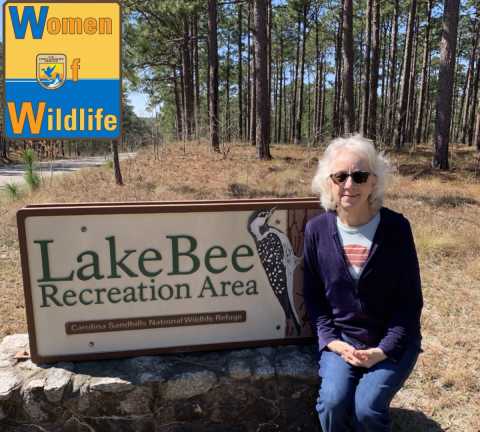Reducing stress. Mindfulness. Physical and mental fitness.
Yoga instructor Deborah Adams touts those as some of the benefits of the discipline. She says the same benefits can be enjoyed by taking part in recreational activities at the Carolina Sandhills Wildlife Refuge.
“I want generations to come enjoy the refuge and experience being in nature, which is undisturbed, quiet, peaceful and a place for contemplation,” says Adams who lives in Chesterfield, South Carolina, not far from the refuge.
One might think this business-minded grad of Saint Leo and Webster Universities might spend her time crunching numbers. Since she retired though, the only crunch she hears is the sound of her feet walking through the longleaf pine forest or along trails and roads that make up the 45,000-acre national wildlife refuge national wildlife refuge
A national wildlife refuge is typically a contiguous area of land and water managed by the U.S. Fish and Wildlife Service for the conservation and, where appropriate, restoration of fish, wildlife and plant resources and their habitats for the benefit of present and future generations of Americans.
Learn more about national wildlife refuge , she discovered just 25 miles from where she grew up in Cheraw, South Carolina.
To make her Carolina Sandhills Refuge exploits even more interesting, Adams often invites others to join her. She shares the advantages of exploring the refuge is many ways.
For example, she started a ladies’ hiking group, representing the Chesterfield and Cheraw areas in South Carolina. She routinely guides them through the refuge, pointing out species who call it home, including the endangered red-cockaded woodpecker.
“I love to go on hikes with my friends and show them the beauty of the refuge,” Adams says. “I also want to show women that the refuge is a safe place to hike and walk alone.”
Since she retired in 2013, Adams has volunteered to serve on the board of the Friends of Carolina Sandhills National Wildlife Refuge. Almost 200 volunteer friends’ groups exist at refuges around the country.
All refuge friends’ organizations share the same primary mission: the support of a refuge, complex of refuges or program of the U.S. Fish and Wildlife Service.
Refuge friends’ groups have flourished since the passage of the Volunteer and Community Partnership Act of 1998, which directs the Refuge System to encourage volunteer assistance, facilitate non-federal partnerships, and encourage donations by organizations.
“Deb is our connection to the community. She is engulfed in the area in unique ways and, among her network, she has helped raise awareness of the Carolina Sandhills National Wildlife Refuge. As a refuge ambassador, she encourages folks to explore the refuge and participate in events sponsored by our friends’ group, like Youth Fishing Day or Fall Owl Prowl,” says Lyne Askins, project leader at the refuge.
Like Carolina Sandhills National Wildlife Refuge, other public lands managed by the Service offer a multitude of recreational opportunities consistent with the organization’s conservation mission. Opportunities for outdoor recreation draw millions of people each year to national wildlife refuges, boosting local economies.
Many visitors enjoy hiking, paddling, wildlife viewing or nature photography. Others take part in heritage sports such as hunting and fishing.
Hunting is available at almost 400 national wildlife refuges, more than 35 wetland management districts and almost 20 national fish hatcheries. Hunting is a priority public use at national wildlife refuges. Wildlife hunting is subject to sustainable limits and sometimes used as a management tool to keep wildlife populations in check. Hunters' purchase of Duck Stamps helps buy conservation lands. Hunters must have an appropriate state license.
Fishing is available at more than 340 national wildlife refuges, 35 wetland management districts, almost 20 national fish hatcheries and other Service lands and waters. Virtually every type of sport fishing is represented. Anglers must follow state and federal regulations, and check individual sites for season dates and size, day, and possession limits.
A relatively small number of Service sites allow backpack camping or RV camping.
All these activities offer visitors a chance to unplug from the stresses of modern life and reconnect with their natural surroundings. Some refuges offer things to see and do year-round; others are season specific. Generally, dawn and dusk are the best times to catch sights of wildlife.
“There is so much to explore and so many great places on the refuge for fishing, birding, hiking, picnicking and family gatherings -- and the array of wildflowers and blooming plants is spectacular,” Adams says.
Editor’s note: During Women’s History Month, the U.S. Fish and Wildlife Service celebrates the accomplishments and commitment of women throughout the organization. The Women of Wildlife, or WOW, story series highlights some of the women serving in the Southeast Region.





